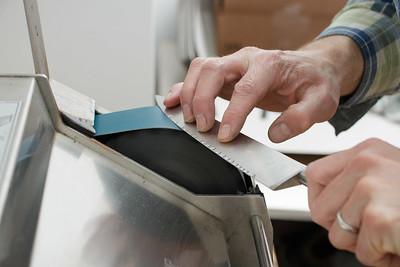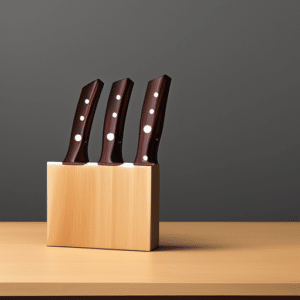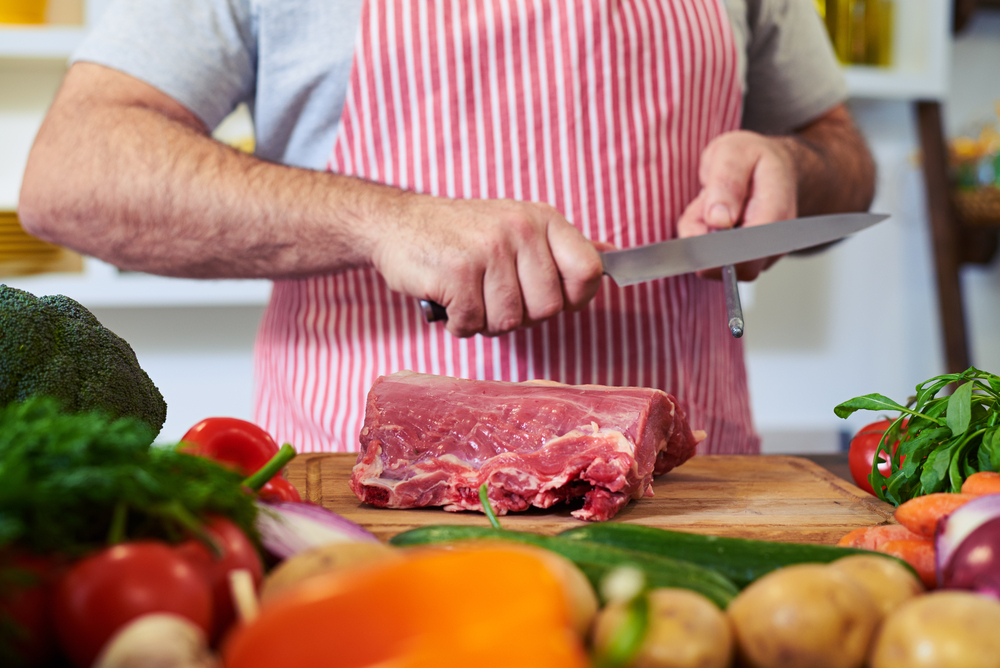Steak knives are incredibly useful for tackling tougher cuts of meat. With minimum effort, serrated knives can cut through steak, beef joints, and other meats like gammon and pork. They enhance the enjoyment aspect of your meals and make cutting and slicing meat a fun chore. This guide will comprehensively discuss how to sharpen steak knives in different ways.
It is essential to understand this process because, unfortunately, even the best quality steak knife will not stay sharp forever. Unless you want to spend a fortune replacing your steak knives every now and then, it is wiser to learn various sharpening techniques. This includes using a ceramic sharpening rod, other manual sharpeners, and electric tools.
Sharpening Steak Knives – Three Different Methods
There is more than one method for sharpening serrated knives. Which method you choose depends on your confidence, skill level, and the type of knives. We have listed the three most common ways below so you can choose.
Method 1: Using a Ceramic Sharpening Rod
Some people prefer the traditional approach to serrated knife sharpening. This is done by using a ceramic rod. A ceramic rod is a special sharpening tool that requires manual operation. It typically has an ergonomic handle and an attached rod made of ceramic that is used for the sharpening process.
Ideally, you want to sharpen rods with a grit of 1000, which allows you to get a finer edge on the blade.
First, hold your serrated bread knife or steak knife with the pointed part of the blade facing away from you. Next, place the rod in the serration of the blade and draw it through the serration gently and slowly. You should repeat this process several times for each serration of the knife. Do not use a back-and-forth motion – draw the rod back over the serration, lift it off, place it again, and repeat.
Once you have finished this process, you can also pass the blade’s edge over a leather strop to get an excellent finish. The following are the pros and cons of this method:
Pros
- It gives the longest-lasting sharpening out of the three methods
- Results in the best-quality sharpening when done properly
- You can achieve a more refined finish
Cons
- The most time-consuming method
- Requires greater patience and skill to use ceramic rods
- It can be potentially dangerous
Method 2: Using a Triangle Sharpener
The following method involves using a triangle sharpener. A triangular sharpened is designed specifically for use with serrated blades. This is because the serrated edge typically has a triangular shape. Therefore, a triangular sharpener can fit into the groove of the serration better.
First, take your kitchen knives or steak knives and hold the pointed edge of the blade away from your body. Next, place the triangle sharpened onto the serration. Due to the triangular shape, the sharpener should fit better. Once in place, draw it backwards with a slow and gentle stroke across the serration. Do not draw it back and forth to reduce potential injuries, as with the ceramic tool.
You should repeat this process several times for each serration. You can also improve the blade edge using a leather strop like the ceramic method. The following are the pros and cons of this method:
Pros
- It gives a long-lasting knife edge and should need sharpening less
- Results in an excellent quality blade’s edge when done properly
- You can achieve a super fine finish using a strop
Cons
- It is quite time-consuming, like using a ceramic tool
- Requires patience, skill, and a gentle touch to use effectively
- It can be potentially dangerous
Method 3: Using an Electric Sharpener

Lastly, if you are not confident using a manual sharpener, you can always use an electric knife sharpener. These are electrical appliances that make the sharpening process incredibly easy. You can sharpen serrated knives in a matter of minutes with minimum effort.
Typically, electric sharpeners have a chassis that contains the motor and sharpening mechanism. They also have a series of slots. The slots contain sharpening rods, and this is where you sharpen kitchen knives and other knives.
The exact process for using an electric sharpener varies depending on the model you have bought. In most instances, you must first plug in the device. Next, you usually have to place the sharp edge of the serrated blade into the slot. While doing this, you should press down the heel of the serrated blade to connect with the sharpener’s grindstone.
Most electric knife sharpeners will have an automatic angle guide, so you don’t have to worry about where you place the blade. Once it is in the slot, the power should be turned on. This will activate any mechanism for the grindstone blocks. Once it is on, slide smoothly through the slot down the entire length of the blade. Repeat this process several times, and this should sharpen a serrated knife. The following are the pros and cons of this method:
Pros
- Requires far less skill and effort than a manual method
- Can sharpen a serrated knife in a much quicker time
- Less chance of cutting yourself on the knife
Cons
- Much more expensive than a simple manual tool
- It does not give greater control compared to a manual method
- It may not result in a quality serrated knife blade compared to manual sharpening
- Not every electric knife sharpener can sharpen serrated knives
Caring for Your Steak Knives – Maintenance Tips
Now that you understand the different methods, like a sharpening rod, we can provide some essential tips for using your serrated knife sharpener.
1. Keep Your Steak Knives in a Knife Block.

Firstly, storage is essential to improve the longevity of your knives. Most people place their steak knives in their kitchen drawers. This is a bad idea and can degrade the blades’ edge quality. This is because the blade will dull when it continually comes into contact with other metals.
As a result, you should store your serrated knives in a knife block or use a magnetic holding strip on your kitchen wall.
2. Dry Thoroughly Before Storage.
While it is OK to wash your serrated knives, you must dry them thoroughly before storing them. Ideally, it would help wash them separately from other cutlery and kitchen items to reduce contact. Also, once they are washed, make sure there is no water left on them.
Any excess water and moisture can result in rust. Hence, the quality of your knives will degrade quickly.=
3. Never Wash Steak Knives in a Dishwasher.
You should also avoid using a dishwasher for steak knives. Even if it states that the knives are dishwasher friendly, we advise against this. The motion of the dishwasher and the harshness of the washing process could damage the knives. Serrations contribute to the dulling of the blades.
Thus, it would be best to wash your steak knives by hand. Also, we advise not to use a glass cutting board when cutting with knives. The hard surface of the glass cutting board could dull the blades.
4. Sharpen Only When Needed and Not Too Often.
Lastly, it is important not to oversharpen your knives or sharpen them too much. Depending on your usage, you should only sharpen a serrated knife every few months. It shouldn’t need doing more than this – even for basic quality steak knives.
Surprisingly, you help reduce its longevity by sharpening the knife’s blade too often. When sharpening, you are actively filling material from the blade. Eventually, there will be no material left to sharpen, and your knives will be useless! Therefore, it would help if you achieved a fine balance of keeping the knives sharp but not over-sharpening them.
Look After Your Steak Knives for a Superior Dining Experience
Steak knives are brilliant appliances to have for any kitchen. When eating tougher meats like steak and beef joints, a high-quality set of steak knives can make the experience that much more enjoyable. No one wants to try and tackle tough meat with a standard cutlery knife!
This is why looking after your steak knives and making sure they are sharp is important. It would be really helpful if you got the gist of how this process works and you learned to sharpen your knives, including electric sharpeners and manual tools.
Steak Knife Sharpening FAQs
How Often Do I Need to Sharpen My Steak Knives?
This depends on how often you use your knives and the quality of the blades. Premium knives should need sharpening less. In comparison, cheap knives will dull more quickly. Depending on usage, you should sharpen your knives every few months as an approximate guide.
Can You Sharpen Knives Too Much?
Absolutely no. When sharpening knives, you are essentially filing away the material of the blade. This reduces its overall lifespan. Therefore, if you sharpen too much and are too heavy-handed, you can significantly reduce the knife’s longevity.
Is a Manual Sharpener or Electric Sharpener Better?
This depends on your level of skill and your enthusiasm. A manual tool is better if you want expert control and a finer result. However, if you are less confident and want a quicker process, an electric sharpening tool is better.
Can a Sharpener Ruin a Knife Blade?
Yes. If you do not use these tools properly, you can risk damaging the blade and ruining your knives. Always take care and complete the sharpening process slowly.
Have a Sumptuous Steak Meal With Your Steak Knife
You won’t relish the taste of your steak meal if your knife is dull. This is why it pays to know how to sharpen steak knives. With sharpened serrated knives, you’ll always be at ease eating your steak. Enjoy your meal!

